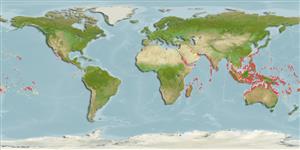Environment: milieu / climate zone / depth range / distribution range
Ökologie
seewasser riff-verbunden; tiefenbereich 2 - 25 m (Ref. 90102). Tropical; 30°N - 30°S
Indo-Pacific.
Size / Gewicht / Alter
Maturity: Lm ? range ? - ? cm
Max length : 29.0 cm TL Männchen/unbestimmt; (Ref. 30573); common length : 18.0 cm TL Männchen/unbestimmt; (Ref. 30573)
Rückenflossenstacheln (insgesamt) : 5; Rückenflossenweichstrahlen (insgesamt) : 21 - 22; Afterflossenstacheln: 1; Afterflossenweichstrahlen: 17 - 18. Easily identified by the large black blotch on the tail. Body and head spotted, except in large males that feature lines on the cheek instead (Ref. 48636). Upper third of body greenish to brownish grey, flecked with dark brown, the lower two-thirds white with 3 or 4 longitudinal rows of small dark brown spots, sometimes linked by narrow dark stripes except lower row as discrete yellow-edged black spots. Caudal fin with a very large black spot centrobasally in fin. Last membrane of spinous portion of dorsal fin connected to first dorsal-fin ray nearly at height of fifth dorsal-fin spine (Ref 42740).
Found on sand and rubble bottoms of shallow lagoon and protected seaward reefs (Ref. 9710, 48636). Also Ref. 58652.
Life cycle and mating behavior
Geschlechtsreife | Fortpflanzung | Ablaichen | Eier | Fecundity | Larven
Randall, J.E., G.R. Allen and R.C. Steene, 1990. Fishes of the Great Barrier Reef and Coral Sea. University of Hawaii Press, Honolulu, Hawaii. 506 p. (Ref. 2334)
IUCN Rote Liste Status (Ref. 130435: Version 2024-2)
Bedrohung für Menschen
Harmless
Nutzung durch Menschen
Fischereien: weniger kommerziell; Aquarium: Kommerziell
Tools
Zusatzinformationen
Download XML
Internet Quellen
Estimates based on models
Preferred temperature (Ref.
123201): 24.9 - 29.3, mean 28.3 °C (based on 3415 cells).
Phylogenetic diversity index (Ref.
82804): PD
50 = 0.5000 [Uniqueness, from 0.5 = low to 2.0 = high].
Bayesian length-weight: a=0.00813 (0.00502 - 0.01317), b=3.11 (2.97 - 3.25), in cm total length, based on LWR estimates for this species & Genus-body shape (Ref.
93245).
Trophic level (Ref.
69278): 3.6 ±0.3 se; based on diet studies.
Generation time: 2.4 ( na - na) years. Estimated as median ln(3)/K based on 1
growth studies.
Widerstandsfähigkeit (Ref.
120179): hoch, Verdopplung der Population dauert weniger als 15 Monate. (K=0.4).
Fishing Vulnerability (Ref.
59153): Low to moderate vulnerability (28 of 100).
Nutrients (Ref.
124155): Calcium = 70.3 [38.9, 107.2] mg/100g; Iron = 0.585 [0.371, 0.959] mg/100g; Protein = 18.2 [16.0, 20.2] %; Omega3 = 0.0888 [, ] g/100g; Selenium = 29.6 [16.4, 54.9] μg/100g; VitaminA = 85.4 [31.5, 225.3] μg/100g; Zinc = 1.32 [0.93, 1.82] mg/100g (wet weight);
